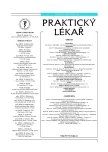The immunopathogenesis of atherosclerosis: C-reactive protein, complement, and regulatory proteins
Imunopatogeneze aterosklerózy: C-reaktivní protein, komplement a regulační proteiny
Chronické zánětlivé reakce probíhající v cévní stěně jsou podkladem vzniku aterosklerózy. C-reaktivní protein je snadno měřitelným ukazatelem aktivity těchto zánětlivých reakcí. Současně je CRP i jejich aktivním účastníkem. Postavení CRP v patogenezi aterosklerózy je dvojjediné: na samém počátku aterosklerotického procesu vykazuje CRP protizánětlivé účinky, které chrání cévní stěnu před ukládáním aterogenních lipoproteinů. Genetická dispozice organismu a vliv zevních rizikových faktorů mění tyto původně ochranné účinky CRP v účinky prozánětlivé, které podporují rozvoj aterosklerózy. Ochranné, protizánětlivé působení i prozánětlivé, aterogenní působení CRP je založeno na aktivaci komplementové kaskády. Ochranné působení CRP spočívá v aktivaci komplementu na úroveň fragmentů C3b/iC3b. Podmínkou je účast regulačního faktoru H. CRP může také přímo indukovat tvorbu membránových regulačních faktorů, mezi nimiž vyniká decay-accelerating factor. Membránové regulační faktory tvoří součást buněčných membrán, na prvním místě jmenujme membrány endotelových buněk, které tak jsou chráněny před autodestruktivními účinky aktivovaného komplementu. K plazmatickým regulačním faktorům se rovněž počítá clusterin/apolipoproteinJ. Podle nových poznatků však tento působek patří mezi tzv. stresové proteiny, které se vyznačují celkově ochranným působením na buněčné struktury. Ochranné působení CRP založené na spolupráci s regulátory aktivace komplementu má obdobu v terapeutických účincích inhibitorů enzymu HMGCoA reduktázy neboli statinů.
Klíčová slova:
ateroskleróza – C-reaktivní protein – komplement – regulační faktory – statiny.
Authors:
P. Kuneš
Authors‘ workplace:
Kardiochirurgická klinika FN a LF UK, Hradec Králové
přednosta prof. MUDr. J. Dominik, CSc.
Published in:
Prakt. Lék. 2005; 85(1): 4-9
Category:
Reviews
Overview
Chronic inflammatory reactions which affect the arterial wall can be viewed as an underlying cause of atherosclerosis. C-reactive protein is an easily measurable marker which reflects the activity of inflammatory responses. At the same time, CRP represents an active partaker of the inflammatory process. The role CRP plays in the pathogenesis of atherosclerosis is ambivalent: at the very beginning, it displays anti-inflammatory properties which contribute to the protection of the arterial wall from atherogenic lipoproteins. Later on, genetic disposition of the host and the influence of many known risk factors convert CRP’s antiinflammatory activity into a net pro-inflammatory effect which boosts the development of atherosclerosis.
Both the protective anti-inflammatory and the noxious pro-inflammatory activities of CRP reside in its capacity to activate the complement cascade. The protective effect of CRP, which is dependent on the plasmatic regulatory factor H, is carried out by the activation of complement up to the level of fragments C3b/iC3b. Further, CRP directly induces production of the complement membrane regulatory proteins, most important of which is the decay-accelerating factor. Membrane regulatory factors form an integral part of the outer cellular membrane, most importantly that of endothelial cells, resulting in protection of the latter from autodestructive attacks inflicted by activated complement. One of the complement regulatory factors is represented by clusterin/apolipoproteinJ. However, according to recent studies, clusterin/apoJ belongs rather to a group of stress proteins, which display overall protective effects on cellular protein structures. Protective activities of CRP based on its cooperation with complement regulatory factors are closely mimicked by the HMG-CoA reductase inhibitors or statins.
Key words:
atherosclerosis – C-reactive protein – complement – regulatory factors – statins.
Labels
General practitioner for children and adolescents General practitioner for adultsArticle was published in
General Practitioner

2005 Issue 1
- Memantine in Dementia Therapy – Current Findings and Possible Future Applications
- Memantine Eases Daily Life for Patients and Caregivers
- What Effect Can Be Expected from Limosilactobacillus reuteri in Mucositis and Peri-Implantitis?
- Metamizole at a Glance and in Practice – Effective Non-Opioid Analgesic for All Ages
Most read in this issue
- Multiple osteolytic foci – a differential diagnostic approach (case report)
- Treatment of primary anorgasmia
- Lithiasis in otorhinolaryngology
- Responsiveness is one of the important objectives and criteria of quality in healthcare
